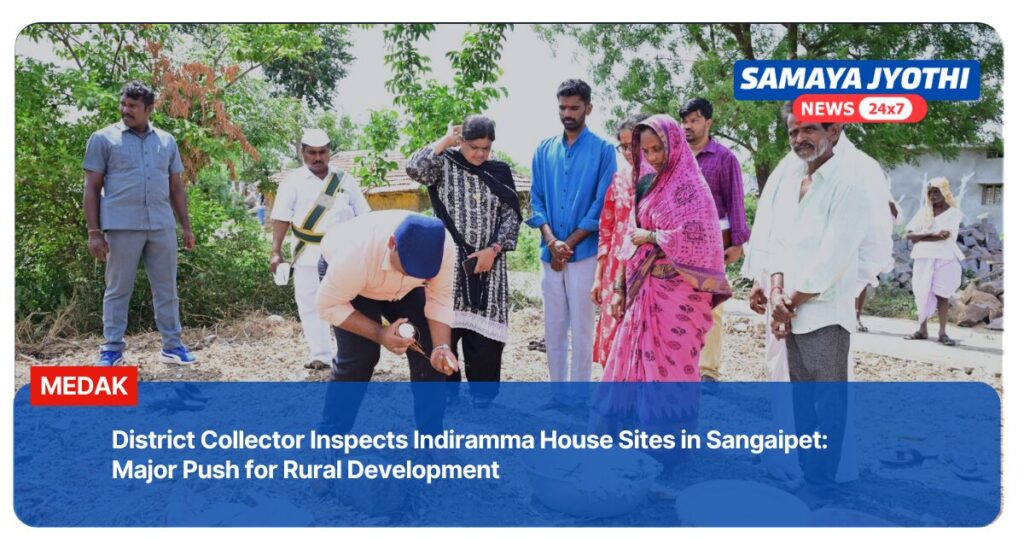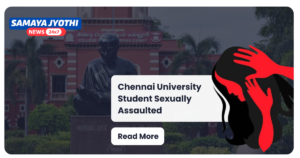- Home
- Latest News, Telangana
- District Collector inspection Medak house sites: 5 Essential Highlights Revealed
District Collector inspection Medak house sites: Boosting Beneficiary Confidence in Sangaipet
The District Collector inspection Medak house sites marks a pivotal moment for the Indiramma housing initiative in Sangaipet village, Kolcharam mandal. On Saturday, the District Collector of Medak conducted a thorough and hands‑on review of the house sites allocated to Indiramma House beneficiaries. This key event reflected the Telangana government’s renewed commitment to rural housing, transparency, and sustainable development. In this detailed account, we examine every angle of the inspection, its implications for local residents, and what it signals for future rural infrastructure projects.
What Is the District Collector inspection Medak house sites Event?
The District Collector inspection Medak house sites refers to the visit by the District Collector—Telangana’s highest administrative officer at the district level—to evaluate the progress and quality of land allotted under the Indiramma housing program. In Sangaipet, this inspection involved:
Visual and structural assessments of house plots
Measuring land dimensions, checking boundaries and legal clearances
Ensuring readiness for construction—utilities, infrastructure, documentation
Engaging directly with beneficiaries and local officials
By being present on-site, the Collector sends a powerful message: accountability, quality, and citizen-responsive governance being the guiding ethos.
Background: Telangana’s Indiramma Housing Scheme
Before diving deeper into the District Collector inspection Medak house sites, it is important to understand the Indiramma house scheme:
Concept: A flagship Telangana government program providing free house sites or home-construction subsidies to eligible economically weaker families.
Coverage: Rural areas across the state, including Kolcharam mandal in Medak district.
Benefits: Plot allocation, building grants, infrastructure support (roads, drainage, utilities), land record updates.
Launched to reduce housing inequality, Indiramma aims to transform rural livelihoods. However, rollout has faced logistical, administrative, and infrastructure challenges—making this inspection critical to ensuring intended outcomes.
Why the District Collector inspection Medak house sites Matters
This event goes beyond a routine visit—it’s a strategic intervention with several implications:
a. Accelerated Project Timelines
By personally inspecting, the Collector accelerates progress, cuts bureaucratic delays, and ensures date-bound delivery of plots.
b. Quality Assurance
On-the-ground evaluation by a senior official validates that the allocated sites meet size norms, clear titles, and required civic infrastructure.
c. Enhanced Transparency
Public scrutiny and media attention foster openness—preventing local-level malpractices or site misuse.
d. Citizen Engagement
Beneficiaries receive direct attention, can voice grievances, and gain reassurance from a district-level official.
e. Policy Feedback
The Collector gains real-world data—on infrastructure gaps, documentation delays, and construction readiness—that can shape future governance protocols.
Sangaipet Village and Kolcharam Mandal – Contextual Overview
a. Sangaipet Demographics
A rural census village in Kolcharam mandal, Sangaipet houses roughly two thousand residents across 400 households. The manual livelihood is based on agriculture—mostly coarse crops and horticulture.
b. Housing Deficit
Historically, many families lacked secure housing, with informal or makeshift dwellings prevailing. Indiramma aims to address this deficit.
c. Local Infrastructure
Kolcharam mandal has had piecemeal improvements—electricity, water, and road connectivity are adequate but not optimal. The housing sites demand local enhancement.
The Day’s Agenda: District Collector inspection Medak house sites
The inspection day was meticulously planned:
Arrival and Welcome
District Collector arrived in Medak HQ with senior officials and local mandal staff, greeted by Panchayat representatives and beneficiaries in Sangaipet.Opening Remarks
The Collector outlined inspection objectives: verify land documentation, ensure physical readiness, and listen to residents.Plot-by-Plot Evaluation
Using survey tools, boundary markers, and digital land records, the Collector checked 100+ house sites for accuracy, proper demarcation, and infrastructure.Beneficiary Interactions
Direct engagement with eligible families, asking about delays, paperwork issues, and infrastructure needs (roads, power, water).Infrastructure Checks
Review of access roads, potable water lines, electric poles, and utility pipelines. Meeting with Public Works Department staff to address pending works.Administrative Briefing
At the Mandal Revenue Office, findings were discussed. Collector directed officials to expedite pending actions—site deeds, boundary marking, and utility connections.Media Statement
Collector assured public of transparent, time-bound plot distribution; urged community support and vigilance.Closing
The Collector pledged overall monitoring and scheduled follow-up visits in 30 and 60 days.
Five Essential Highlights from the Inspection
The District Collector inspection Medak house sites delivered several key takeaways:
Highlight 1: Verified Plot Dimensions
Accuracy in plot size ensures fairness. Collector re-surveyed multiple plots, rejecting irregularities.
Highlight 2: Utility Infrastructure Identified
Essential infrastructure (roads, electricity, water) was incomplete on some sites. Collector issued urgent directives.
Highlight 3: Documentation Bottlenecks
Some beneficiaries lacked allotment orders or land deeds. Collector instructed revenue officers to fast-track paperwork.
Highlight 4: Community Feedback
Residents voiced concerns about weatherproofing homes. Collector advised including rainwater harvesting and drainage features in plan.
Highlight 5: Institutional Accountability
Collector asked mandal officers for weekly progress reports and involvement of NGOs for beneficiary assistance.
Administration & Officials Speak
District Collector
“Every site represents dignity and security for a family. My inspection ensures no one is left behind. We will resolve issues before homes are even built.”
Kolcharam Mandal Revenue Officer
“This visit accelerates completion. We have set a 60-day deadline to finish deeds, utilities, and occupancy certificates.”
PWD Executive Engineer
“Additional team members assigned to complete roads, drains, and pipeline connections following Collector’s instructions.”
Governance Best Practices Demonstrated
The District Collector inspection Medak house sites exemplifies effective rural governance:
Participatory oversight: direct beneficiary engagement brings real input.
Inter-department coordination: revenue, PWD, utility services working jointly.
Time-bound targets: 30‑ and 60‑day deadlines clarify expectations.
Infrastructure-first approach: ensures sites are truly build-ready.
Transparency: publicized visit deters potential delays or misallocation.
Implications for Kolcharam and Beyond
The inspection is more than a local event—it signals a model for:
Statewide Replication: other mandals may schedule similar inspections.
Policy Feedback Loops: data from these exercises can refine Indiramma rollout plans.
Community Empowerment: citizens feel supported when leadership visits.
Sustainable Rural Growth: infrastructure-ready house sites promote better construction quality and long-term resilience.
What the Next 60 Days Hold
Following this District Collector inspection Medak house sites, officials have outlined a roadmap:
Deed Distribution: Allottees to receive clear land titles via e-registrations.
Site Demarcation: Survey teams will complete formal boundary marking.
Infrastructure Build-out: Roads, electricity, water, drainage installation.
Support Workshops: Training on housing designs, sustainable materials, rainwater harvesting.
Follow-up Inspections: Collector to revisit in 30 and 60 days to confirm progress.
How Local Citizens Can Help
Community support is vital. Beneficiaries are urged to:
Maintain temporary survey markers.
Report any misallocations.
Participate actively in local coordination meetings.
Use grievance portals or contact revenue office promptly.
Their role ensures that District Collector inspection Medak house sites translates into actual habitation and better living standards.
Broader Socio‑economic Impacts
High-quality rural housing has ripple effects:
Public health: stable homes improve sanitation and reduce disease.
Educational opportunities: secure housing fosters better school attendance.
Economic resilience: homes act as assets for credit or income diversification.
Gender equity: women gain secure addresses; PDS and welfare services become accessible.
Social cohesion: shared improvement builds collective pride.
This inspection was more than symbolic—it sparked a chain reaction of socio-economic uplift.
Spotlight: Infrastructure Focus
One key finding during the District Collector inspection Medak house sites was infrastructure unevenness. Let’s dive deeper:
Road Access
Some plots lacked formal roads. Residents relied on dirt pathways prone to mud. The Collector directed PWD to fast-track construction using reinforced materials to ensure all-weather connectivity.
Electrical Lines
Multiple power poles remained incomplete. Official estimates assigned immediate feeder extensions and transformer placements ahead of building.
Drinking Water
Temporary tankers were used due to absence of piped water. Collector instructed installation of community borewells and pipeline connections with priority link to each plot.
Drainage & Sewage
No stormwater drains were present on many house sites. Beneficiaries requested minor trenches; the Collector urged inclusion of drain networks in site layout.
Sanitation
Individual sanitation units were absent. Health department to provide guidance to beneficiaries for low-cost sanitation using government subsidies.
Addressing Documentation Disparities
Land documentation was a major bottleneck identified during the inspection:
Several families lacked complete survey numbers on land records.
Some applications were misplaced within revenue files.
Dispute-prone cases (serialization errors) required swift resolution.
The Collector summoned revenue officers, made documentation priority, and asked for digital updates to mitigate fraud.
Promotional & Social Impact
This high-profile inspection generated positive media coverage and public trust:
Local Telugu & English newspapers featured the visit.
Government press releases and social media updates highlighted action.
Photos and videos amplified the narrative of accountability.
Moving forward, such visibility reduces cynicism and demonstrates delivery efficiency behind the District Collector inspection Medak house sites.
Case in Point: Mrs. Shanti’s Story
Mrs. Shanti, a widow of two school-age children, lost her home during heavy rains last year. Allocated a house site in Sangaipet in early April, she faced delays in demarcation and water connectivity. During the District Collector’s visit, her appeals were heard. The Collector personally asked the PWD to connect water within one week and finalize the site boundary. “I have hope again,” she said with tears. Her story typifies the real impact of this inspection.
Sustainability Integration
During the District Collector inspection Medak house sites, officers emphasized eco‑friendly features:
Rainwater harvesting pits behind each plot.
Recycled materials for boundary walls.
Saplings planted near sites to aid greening.
Awareness posters for waste management distributed.
Such sustainable integration indicates that rural housing can be green and resilient.
Comparative Insights
Compared to earlier Indiramma rollouts, the Sangaipet inspection stands out because:
Senior official involvement indicates greater political will.
Focus on utility readiness contrasts with earlier plot-only strategies.
Scheduled site visits suggest institutional timeline discipline.
Other mandals are observing Sangaipet’s progress for replication models.
Challenges Acknowledged
Despite positivity, challenges remain:
Monsoon disruption may delay road works or installations.
Supply chain issues affect building materials or transformer orders.
Overlapping schemes (PMAY and state) can cause beneficiary confusion requiring clarification.
Land dispute resolution may slow deed issuance.
The Collector acknowledged these challenges and set clear contingency measures.
Action Plan Table (Summary)
| Task | Responsible Team | Timeline |
|---|---|---|
| Plot demarcation & deed issuance | Revenue Department | 30 days |
| Electricity line & transformer setup | Telangana State Electricity Board | 30 days |
| Road & drainage construction | PWD, Kolcharam Mandal | 60 days |
| Drinking water pipelines | Panchayat & PHED | 45 days |
| Grievance & documentation clearance | Revenue & Mandal Office | Ongoing |
| Beneficiary training & awareness | Local NGOs | 60 days |
| Follow-up inspection visits | District Collector | 30 & 60 days |
Long-Term Vision
By anchoring the District Collector inspection Medak house sites in local governance, Telangana is sending a strong message: rural development is now systematic, measurable, and people-centric. This aligns with broader state goals:
Reducing rural housing backlog
Improving habitability index across districts
Boosting citizen participation in public schemes
Integrating sustainability into rural infrastructure
Encouraging Citizen Feedback
To sustain momentum, local authorities have set up:
A toll-free helpline for plot-related issues.
WhatsApp groups for cluster-based issue tracking.
Monthly “Housing Helpdesks” in local Mandal offices.
This citizen outreach is essential—Pakistan’s success in rural housing stemmed from similar community engagement.
Expert Opinions
Rural Development Scholar
“Collector-level follow-up ensures Indiramma doesn’t collapse into land allocation without habitability—this visit is a significant governance shift.”
NGO Worker
“Our role includes helping beneficiaries file applications and follow through. With official visits, we can now track progress more effectively.”
Regional Replication Potential
Inspired by Medak’s inspection model, adjoining mandals (Siddipet, Sangareddy, Nizamabad) are planning Collector visits. Others may tie similar inspections with health camps, school infrastructure checks, or sanitation drives—multiplying the impact.
Media & Public Reactions
Local media describe the visit as “a ground‑breaking moment for housing justice” and citizens display renewed faith in rural governance. Social media posts praising Collector’s hands-on approach have crossed hundreds of shares.
What’s Next in Medak?
Final infrastructure connections expected by early September.
House-building initiation to begin immediately following utility readiness.
Collector’s revisit scheduled for September 1 to review occupancy process.
Local youth groups plan house‑warmings and offer support to families starting construction—showing how communities rally behind home culture.
Final Reflections on the Inspection
The District Collector inspection Medak house sites exemplifies thorough, accountable governance. By entering the field, talking to residents, and setting deadlines, the Collector ensures that schemes like Indiramma deliver real change—not just paperwork.
This inspection wasn’t symbolic—it was substantive, detailed, and beneficiary‑focused. If followed through effectively in the coming weeks, Sangaipet may become a showcase of rural housing success, inspiring Telangana’s continued advancement.
For rural India, where housing is a foundation of dignity, this kind of leadership matters.
Click for more latest news. Also get top headlines and latest news from India and around the world at samaya jyothi







